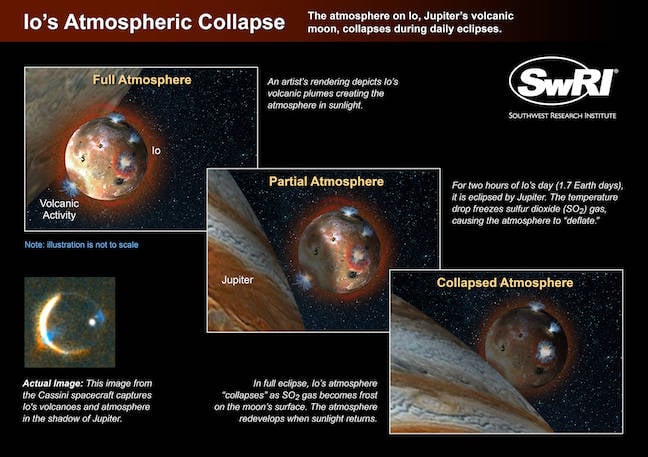This article is more than 1 year old
Jovian moon Io loses its atmosphere every day
When Jupiter blocks the Sun, the sulphur dioxide atmosphere falls as FROST
If you've ever resented crunching frost underfoot on a cold morning, spare a thought for Jupiter's moon Io: when it's in eclipse, the frost on the ground is a big chunk of its atmosphere.
That's the conclusion of research that looked at Io's atmosphere: when it passes behind Jupiter, Io cools down from a balmy -235°F (-148°C) to a frigid -270°F (-168°C), and its mostly sulphur dioxide atmosphere collapses.
NASA, which funded the research, says the eclipse – and the atmospheric collapse – happens for about two hours of each Ionian day (which lasts about 1.7 Earth days). At that time, “most of the sulfur dioxide gas settles as frost on the moon’s surface. The atmosphere redevelops as the surface warms once the moon returns to full sunlight.”
The SO2 comes from Io's volcanoes. The most volcanically-active object in the solar system, Io is pulled around by huge tides, courtesy of the gravity of Jupiter and its other moons.
The resulting volcanoes create both lava fields of basalt, and sends SO2 plumes nearly 500 km above the planet.
As the researchers explain in their paper at the Journal of Geophysical Research (abstract), observing the phenomenon directly needed high spectral resolution, high time sensitivity, and a good signal-to-noise ratio.
To achieve that, they combined observations from the Texas Echelon Cross Echelle Spectrograph and the Gemini North eight-metre telescope in Hawaii.

Artist's impression of the daily freezing of Io's atmosphere. Image: Southwest Research Institute. Click to embiggen
The research was led by boffins from the Southwest Research Institute. ®
